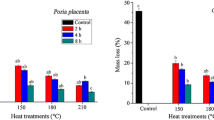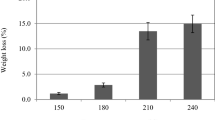Abstract
Heat treatment is an effective method to improve biological resistance of low natural durability wood species. The aim of this study was to enhance the decay resistance of Pinus patula, an African low natural durability softwood species, via wood thermal modification technique. Heat treatment was performed on wood specimens under inert conditions at different heat treatment intensities to reach mass losses of 5, 10 and 15%. Heat treated specimens were exposed to fungal decay using the brown rot fungus Poria placenta. The wood chemical and elemental composition was determined as well as extractives toxicity before and after wood thermal modification to understand the reasons of durability improvement. The treated specimens exhibited a significant increase in their durability against wood decay in line with the severity of the treatment. Wood holocellulose was found to be distinctly more sensitive to the heating process than the lignin constituent. In addition, obvious correlations were observed between weight losses recorded after fungal exposure and both holocellulose decrease and lignin ratio increase. The same correlations were observed with the elemental composition changes allowing using the observed differences for predicting of wood durability conferred by heat treatment. Furthermore, no significant differences were observed between the toxicity of Pinus patula wood extractives before and after its thermal modification.
Zusammenfassung
Wärmebehandlung ist eine effektive Methode zur Verbesserung der biologischen Resistenz von Holzarten mit geringer natürlicher Dauerhaftigkeit. Ziel dieser Studie war es, die Fäuleresistenz von Pinus patula, einer afrikanischen Nadelbaumart mit geringer natürlicher Dauerhaftigkeit, durch eine Wärmebehandlung zu verbessern. Dabei wurden Prüfkörper unter Schutzgas mit unterschiedlicher Intensität wärmebehandelt, um Masseverluste von 5, 10 und 15 % zu erreichen. Die wärmebehandelten Prüfkörper wurden einem Befall mit dem Braunfäulepilz Poria placenta ausgesetzt. Die chemische und Elementzusammensetzung des Holzes sowie die Extraktstofftoxizität wurden vor und nach der thermischen Behandlung bestimmt, um die Gründe der verbesserten Dauerhaftigkeit herauszufinden. Die Dauerhaftigkeit der behandelten Prüfkörper stieg in Abhängigkeit der Behandlungsintensität signifikant an. Die Holzholocellulose reagierte wesentlich stärker auf die Wärmebehandlung als das Lignin. Dabei wurden deutliche Korrelationen zwischen dem Masseverlust und dem Holzcelluloserückgang sowie dem Anstieg des Ligninanteils festgestellt. Die gleichen Korrelationen ergaben sich für die Änderung der Elementzusammensetzung, wodurch die Verwendung der beobachteten Unterschiede zur Vorhersage der Dauerhaftigkeit von wärmebehandeltem Holz möglich ist. Des Weiteren ergaben sich keine signifikanten Unterschiede zwischen der Toxizität der Holzextraktstoffe von Pinus patula vor und nach deren thermischer Behandlung.




Similar content being viewed by others
References
Alén R, Kotilainen R, Zaman A (2002) Thermochemical behavior of Norway spruce (Picea abies) at 180–225 ∘C. Wood Sci Technol 36:163–171
Calonego WF, Durgante Severo ET, Furtado EL (2010) Decay resistance of thermally-modified Eucalyptus grandis wood at 140 ∘C, 160 ∘C, 180 ∘C, 200 ∘C and 220 ∘C. Bioresour Technol 101:9391–9394
Chaouch M, Pétrissans M, Pétrissans A, Gérardin P (2010) Use of wood elemental composition to predict heat treatment intensity and decay resistance of different softwood and hardwood species. Polym Degrad Stab 95:2255–2259
Esteves B, Pereira H (2009) Wood modification by heat treatment: a review. Bioresources 4(1):370–404
Esteves B, Videira R, Pereira H (2010) Chemistry and ecotoxicity of heat-treated pine wood extractives. Wood Sci Technol. doi:10.1007/s00226-010-0356-0
Finney DJ (1971) Probit analysis. Cambridge University Press, Cambridge, 318 p
González-Peńa M, Curling FS, Hale DCM (2009) On the effect of heat on the chemical composition and dimensions of thermally-modified wood. Polym Degrad Stab 94:2184–2193
Hakkou M, Pétrissans M, Gérardin P, Zoulalian A (2005a) Wettability changes and mass loss during heat treatment of wood. Holzforschung 59:35–37
Hakkou M, Pétrissans M, Zoulalian A, Gérardin P (2005b) Investigation of wood wettability changes during heat treatment on the basis of chemical analysis. Polym Degrad Stab 89:1–5
Hakkou M, Pétrissans M, El Bakali I, Gérardin P, Zoulalian A (2006) Investigations of the reasons for fungal durability of heat-treated beech wood. Polym Degrad Stab 9(2):393–397
Mburu F, Dumarçay S, Huber F, Pétrissans M, Gérardin P (2007) Evaluation of thermally modified Grevillea robusta heartwood as an alternative to shortage of wood resource in Kenya: characterisation of physicochemical properties and improvement of bio-resistance. Bioresour Technol 98:3478–3486
Militz H (2002) Thermal treatment of wood: European processes and their background. International Research Group on Wood Protection. IRG/WP 02–40241
Mohareb A, Sirmah P, Desharnais L, Dumarçay S, Pétrissans M, Gérardin P (2010) Effect of extractives on conferred and natural durability of Cupressus lusitanica heartwood. Ann Sci For 67:504
Mouras S, Girard P, Rousset P, Permadi P, Dirol D, Labat G (2002) Propriétés physiques de bois peu durables soumis à un traitement de pyrolyse ménagée. Ann Sci For 59:317–326
Nunes L, Nobre T, Rapp A (2004) Thermally modified wood in choice tests with subterranean termites. COST E37, Reinbeck
Paes JB, Morais VM, Lima CR (2004) Natural resistance of nine woods of semi-arid region of Brazil to wood destroying fungi under laboratory conditions. Rev. Árvore 28(2):275–282 (in Portuguese)
Patzelt M, Stingl R, Teischinger A (2002) Termische Modifikation von Holz und deren Einfluß auf ausgewählte Holzeigenschaften. In: Modifiziertes Holz Eigenschaften und Märkte, LIGNOVISIONEN, vol 3, pp 101–149. ISSN 1681-2808
Peters J, Pfriem A, Horbens M, Fischer S, Wagenführ A (2009) Emissions from thermally modified beech wood, their reduction by solvent extraction and fungicidal effect of the organic solvent extracts. Wood Material Science and Engineering 1(2):61–66
Santos JA (2000) Mechanical behavior of eucalyptus wood modified by heat. Wood Sci Technol 34:39–43
Šušteršic Ž, Mohareb A, Chaouch M, Pétrissans M, Petrič M, Gérardin P (2010) Prediction of decay resistance of heat treated wood on the basis of its elemental composition. Polym Degrad Stab 95:94-97
Unsal O, Ayrilmis N (2005) Variation in compression strength and surface roughness of heat treated Turkish river gum (Eucalyptus camaldulensis) wood. J Wood Sci 51:405–409
Venkatasamy R (2006) Comparing microbial colonization and decay rates of wood from sound and aphid-killed Kenyan grown Mexican cypress (Cupressus lusitanica). International Research Group on Wood Protection. IRG/WP 06-10599
Welzbacher CR, Rapp AO (2007) Durability of thermally modified timber from industrial-scale processes in different use classes: results from laboratory and field tests. Wood Mater Sci Eng 2(1):4–14
Yildiz S, Gezer ED, Yildiz UC (2006) Mechanical and chemical behavior of spruce wood modified by heat. Build Environ 41(12):1762–1766
Yilgör N, Nami Kartal S (2010) Heat modification of wood: chemical properties and resistance to mold and decay fungi. For Prod J 60(4):357–361
Acknowledgements
The authors would like to thank The Région Lorraine, France for its financial support and gratefully acknowledge the scientific visit grant from University of Nancy 2 for the first author during the academic year of 2010–2011.
Author information
Authors and Affiliations
Corresponding author
Rights and permissions
About this article
Cite this article
Mohareb, A., Sirmah, P., Pétrissans, M. et al. Effect of heat treatment intensity on wood chemical composition and decay durability of Pinus patula . Eur. J. Wood Prod. 70, 519–524 (2012). https://doi.org/10.1007/s00107-011-0582-7
Received:
Published:
Issue Date:
DOI: https://doi.org/10.1007/s00107-011-0582-7




